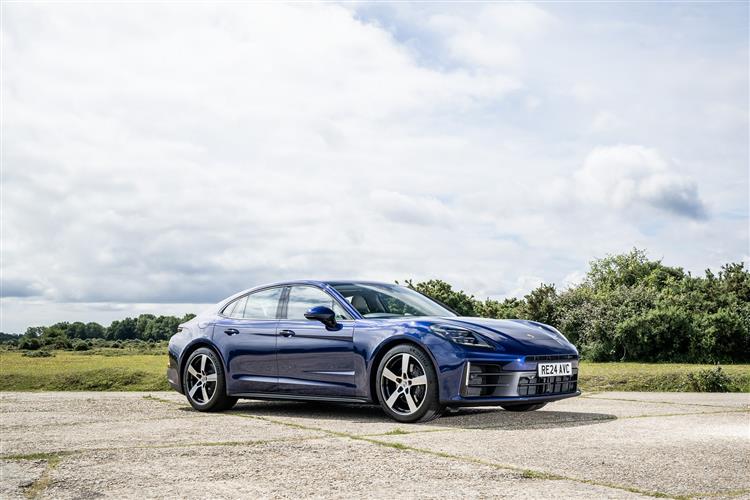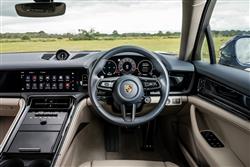PAN-EUROPEAN (some text hidden) --NONE--
By Jonathan Crouch
The third generation version of Porsche's Panamera luxury five-door Gran Turismo model has been usefully evolved. Jonathan Crouch drives it.
Ten Second Reviewword count: 124
Named after the Carrera Panamerican road race, Porsche's Panamera is the brand's offering to Luxury segment buyers wanting spacious rear seat accommodation and a properly sporting Gran Turismo driving experience. This model could have ended up being a four-door version of the company's 911 coupe or a low-slung interpretation of the marque's Cayenne luxury SUV. In the event, it's very much its own car, a long, low five-door hatch that still offers something very different in its sector. This revitalised MK3 model not only looks a little smarter but also offers an improved V8 PHEV option - and an extremely clever 'Active Ride' suspension option. Whatever your preference, for boardroom buyers who yearn for Brands Hatch, this car promises to be a tempting proposition.
Backgroundword count: 251
So there is still to be a place in Porsche's model line for this car, the Panamera. When the similarly sized and shaped all-electric Taycan was launched by the brand in 2020, it did seem as if the Panamera's days might be numbered. Instead, Porsche has produced this third generation model, a subtly evolved version of the second generation design that was first launched in 2017, then updated three years later. Like all Panameras made to date, starting with the MK1 incarnation back in 2009, Porsche sees this as a 'Gran Turismo', the kind of car that allows two rear seat passengers to recline in comfort while the driver enjoys himself. Forget Audi A8s and BMW 7 Series models. Think instead, faster versions of the Audi A7 or Mercedes CLS, perhaps a Maserati Quattroporte or even the old Aston Martin Rapide. In other words, a four-door luxury conveyance to really get the pulses racing. This car won't be chauffeur-driven. It shouldn't be anyway. It would, after all, be such a shame to ignore all of this Panamera's dynamic attributes and merely treat it as a limo. Mind you, if need be this MK3 version can function that way more easily thanks to its greater rear seat space and larger boot. There's also a more digitalised cabin and a clever new suspension system. Lots to talk about then. But does the Panamera still have a credible role to play in a Porsche line-up increasingly focused towards full-electric models? Time to find out.
Driving Experienceword count: 591
Though the Panamera has always been big, wide and heavy, Porsche has always somehow managed to make it feel like a Porsche - and of course nothing's changed in that regard with this G3-era design. Air suspension's now standard and it delivers a truly brilliant combination of supple ride and the kind of connected feel you want from the brand. The steering's just as good, such a perfect combination of feel and response that it's small wonder that Zuffenhausen doesn't want to share its engineering with VW Group partner Audi. Talking of Audi, underpinning all of this is essentially the same Modular Sport Toolkit platform that Porsche had to share with Ingolstadt with the old G2 Panamera model, though for this replacement G3 design, that chassis features significant modifications. The engine range does too, familiar though it might look at first glance. The entry-level 2.9-litre V6 petrol unit we tried (offered with rear or four-wheel drive) has been completely revised, with changes to fuel injection flow rate, ignition timing and boost pressure. Together, these enhancements have increased power output by 23PS - to 353PS. The same 2.9-litre V6 is also used in two six cylinder Plug-in Hybrid variants; the E-Hybrid version (with 470PS) and in the 4S E-Hybrid (with 544PS). Those dramatically increased power outputs come courtesy of a 190PS electric motor inserted into the housing of the heavily revised version of the ZF-built PDK 8-speed dual clutch auto transmission that all Panameras now use. The big difference this time round is that this motor is mated to a much larger battery, boosted in size from 17.9 to 25.9kWh. Hence EV range figures that are almost doubled over the equivalent previous generation models - to 59 miles for the E-Hybrid and 56 miles for the 4S E-Hybrid. There's still a throbbing 4.0-litre twin turbo V8 petrol powerplant for top-of-the-range models, but like the V6 unit it too has been fundamentally altered, with everything different except the block. You can still get this powertrain in conventional form - in the form of the 500PS GTS model, which sprints to 62mph in just 3.8s on the way to 188mph to the accompaniment of a wonderful snarl. But most Panamera customers who want a V8 will order it mated to PHEV tech, where in combination with the E-motor we just mentioned, it produces 680PS in the Turbo E-Hybrid model, allowing 62mph to flash by in just 3.2s on the way to 196mph, with EV range of 57 miles. Should that level of performance be somehow insufficient, you can ask your Porsche Centre about an even more powerful Turbo S E-Hybrid flagship model which offers 782PS, makes 62mph in 2.9s and manages 202mph. EV range is 52 miles. Other than engines, the big choice for Panamera customers lies with suspension. Earlier, we mentioned the standardisation of the air-sprung set-up across the range; it's a 'PASM' 'Porsche Active Suspension Management' adaptive system that combines with a semi-active anti-roll bar and uses more sophisticated two-valve dampers that have allowed Porsche to switch from the previous three-chamber set-up to a simple two-chamber arrangement. And it works both together and independently of the three drive modes ('Normal', 'Sport' and 'Sport Plus'); and can be set at four levels - 'Lift', 'Normal', 'Lowered' and 'Low'. For those who want to go further, Porsche now offers an even more advanced suspension set-up called 'Active Ride', offered as a fearsomely expensive option and only available with the Plug-in Hybrid variants because their 400V hybrid system is necessary to power its hydraulic pumps.
To see the full road test text contact us on 0330 0020 227
Pictures (high res disabled)

.jpg)
|
.jpg)
|
.jpg)
| |||
.jpg)
|
.jpg)
|
.jpg)
| |||
.jpg)
|
.jpg)
|
.jpg)
| |||
.jpg)
|
.jpg)
|

|
Statistics (subset of data only)
Min |
Max |
|
Price: |
£89,400.00 (At 16 Apr 2025, Panamera) |
£175,100.00 (At 16 Apr 2025, Turbo S E-Hybrid) |
Insurance group 1-50: |
50 |
|
CO2 (g/km): |
26 (WLTP) |
230 (WLTP) |
Max Speed (mph): |
167 (Panamera) |
202 (Turbo s E-Hybrid) |
0-62 mph (s): |
4.8 (Panamera) |
2.9 (Turbo S E-Hybrid) |
Electric WLTP-Rated Driving Range (miles): |
52 |
|
Combined Mpg: |
29.4 (Panamera) |
282.5 (4 E-Hybrid) |
Length (mm): |
5052 |
|
Width (mm): |
1937 |
|
... and 3 other stats available | ||
Scoring (subset of scores)
Category: Luxury Saloons and Estates
| Performance | |
| Handling | |
| Comfort | |
| Space | |
| Styling, Build, Value, Equipment, Depreciation, Handling, Insurance and Total scores are available with our full data feed. | |



